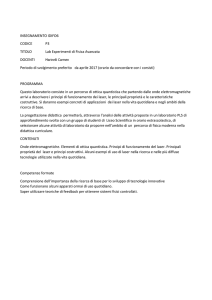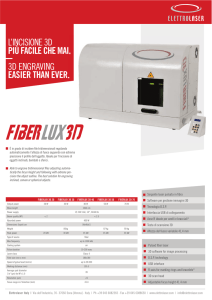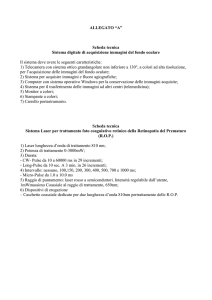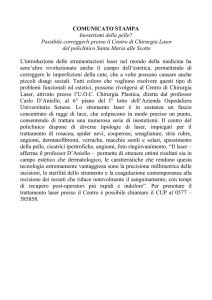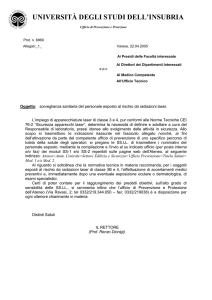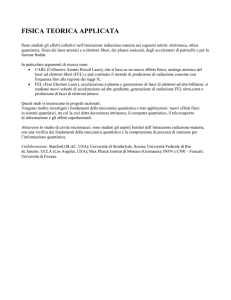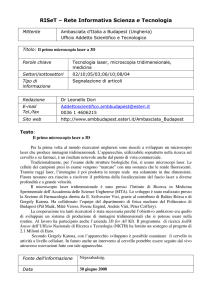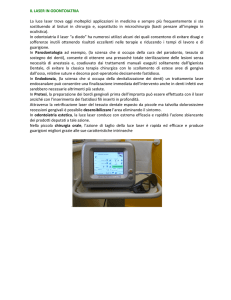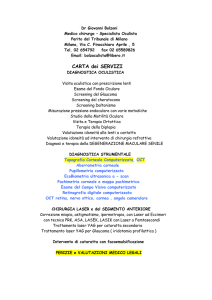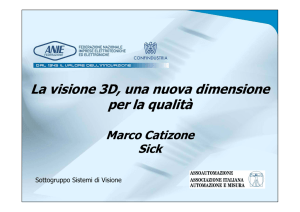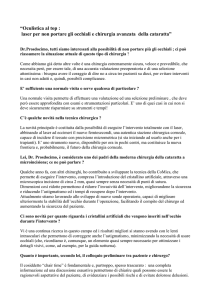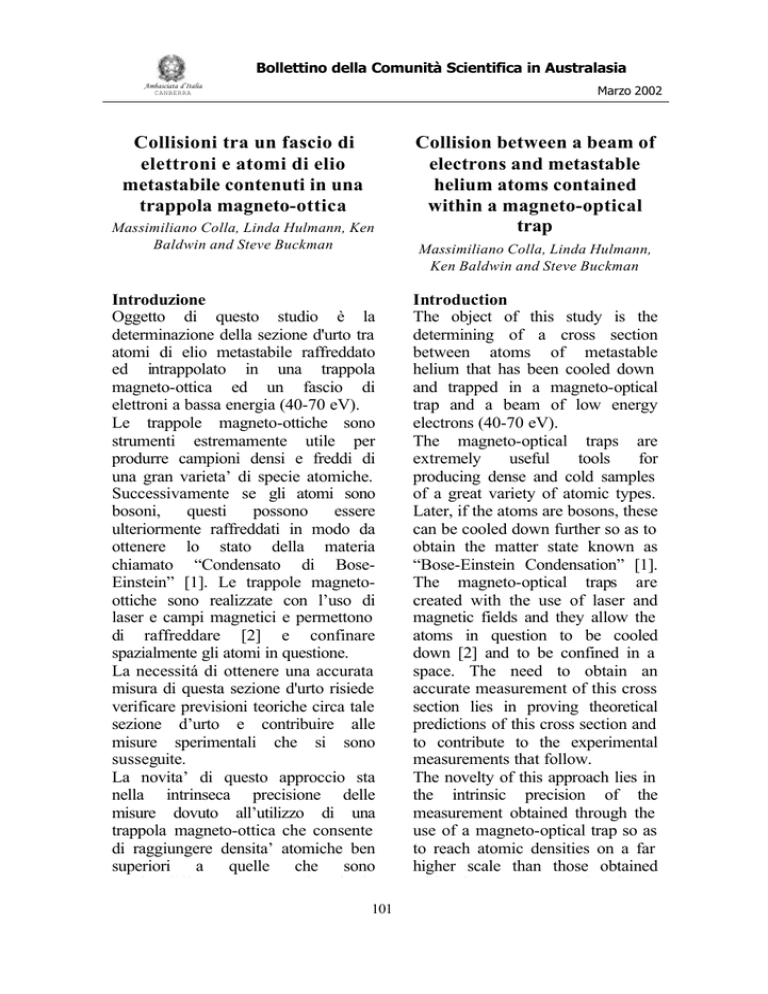
Bollettino della Comunità Scientifica in Australasia
Ambasciata d’Italia
Marzo 2002
CANBERRA
Collisioni tra un fascio di
elettroni e atomi di elio
metastabile contenuti in una
trappola magneto-ottica
Massimiliano Colla, Linda Hulmann, Ken
Baldwin and Steve Buckman
Introduzione
Oggetto di questo studio è la
determinazione della sezione d'urto tra
atomi di elio metastabile raffreddato
ed intrappolato in una trappola
magneto-ottica ed un fascio di
elettroni a bassa energia (40-70 eV).
Le trappole magneto-ottiche sono
strumenti estremamente utile per
produrre campioni densi e freddi di
una gran varieta’ di specie atomiche.
Successivamente se gli atomi sono
bosoni,
questi
possono
essere
ulteriormente raffreddati in modo da
ottenere lo stato della materia
chiamato “Condensato di BoseEinstein” [1]. Le trappole magnetoottiche sono realizzate con l’uso di
laser e campi magnetici e permettono
di raffreddare [2] e confinare
spazialmente gli atomi in questione.
La necessitá di ottenere una accurata
misura di questa sezione d'urto risiede
verificare previsioni teoriche circa tale
sezione d’urto e contribuire alle
misure sperimentali che si sono
susseguite.
La novita’ di questo approccio sta
nella intrinseca precisione delle
misure dovuto all’utilizzo di una
trappola magneto-ottica che consente
di raggiungere densita’ atomiche ben
superiori a quelle che sono
raggiungibile con un solo fascio
101
Collision between a beam of
electrons and metastable
helium atoms contained
within a magneto-optical
trap
Massimiliano Colla, Linda Hulmann,
Ken Baldwin and Steve Buckman
Introduction
The object of this study is the
determining of a cross section
between atoms of metastable
helium that has been cooled down
and trapped in a magneto-optical
trap and a beam of low energy
electrons (40-70 eV).
The magneto-optical traps are
extremely
useful
tools
for
producing dense and cold samples
of a great variety of atomic types.
Later, if the atoms are bosons, these
can be cooled down further so as to
obtain the matter state known as
“Bose-Einstein Condensation” [1].
The magneto-optical traps are
created with the use of laser and
magnetic fields and they allow the
atoms in question to be cooled
down [2] and to be confined in a
space. The need to obtain an
accurate measurement of this cross
section lies in proving theoretical
predictions of this cross section and
to contribute to the experimental
measurements that follow.
The novelty of this approach lies in
the intrinsic precision of the
measurement obtained through the
use of a magneto-optical trap so as
to reach atomic densities on a far
higher scale than those obtained
with just one atomic beam.
Bollettino della Comunità Scientifica in Australasia
Ambasciata d’Italia
Marzo 2002
CANBERRA
raggiungibile con un solo fascio
atomico. Inoltre, la temperatura
relativamente bassa degli atomi
intrappolati (tipicamente 1mK – 300
? K) consente relativamente lunghi
tempi di interazione.
Infine, l’utilizzo di una tecnica
spettroscopica
non
distruttiva,
consente di estrarre utili informazioni
senza alterare gli equilibri della
trappola, cosí migliorando la qualitá
dei risultati.[3]
with just one atomic beam.
Moreover, the relatively low
temperature of trapped atoms
(normally 1mK ÷300µK) enables
relatively long interaction periods.
Finally, the use of a non-destructive
spectroscopic technique enables
useful information to be extracted
without
altering
the
trap’s
equilibrium, thus improving the
quality of the results. [3]
Fig. 1 Diagram of helium energy levels. The arrows show the transitions used for the
laser cooling and for possible fluorescence measurements.
Fig 1 Schema dei livelli energetici dell’elio. Le frecce mostrano le transizioni usate per il
raffreddamento laser e per eventuali misure di fluorescenza
Apparato sperimentale
L’apparato sperimentale consiste in
alcune sezioni ad alto vuoto (10-7 –
10-11 Torr), pompe turbomolecolari,
laser a diodo e uno Zeeman Slower.
La sezione relativa alla trappola
comprende la camera dove avviene
102
Experiment apparatus
The experiment apparatus consists
of some high vacuum sections (107 ÷ 10-11 Torr), turbo molecular
pumps, diode laser and a Zeeman
Slower. The section relative to the
trap includes the chamber where the
Bollettino della Comunità Scientifica in Australasia
Ambasciata d’Italia
Marzo 2002
CANBERRA
comprende la camera dove avviene
l’intrappolamento,
bobine
per
generare ilgradiente di campo
magnetico richiesto dalla trappola
Magneto
Ottica,
un
cristallo
modulatore elettro-ottico, un laser di
sonda, un generatore a radiofrequenza,
un fotodiodo veloce (1GHz) un
analizzatore di spettro ed una cannone
ad elettroni (electron gun) montata
direttamente
sulla
camera
di
intrappolamento.
L’apparato è poi interfacciato ad un
computer incaricato dell’acquisizione
dei dati e della loro elaborazione.
I laser utilizzati per l’esperimento
sono laser a diodo o ad amplificatore a
fibra ottica arricchita di Itterbio. La
lunghezza d’onda utilizzata è 1083 nm
corrispondente ad una transizione
ottica che connette un livello
metastabile dell’elio ad uno stato
eccitato (23S1? 23P2).
Gli atomi di elio vengono eccitati
dallo stato fondamentale (ground
state) a quelli metastabili (metastable)
tramite scarica elettrica, visto che la
transizione è otticamente proibita.
La vita media per lo stato metastabile
23S1 e di circa 8000 sec.; per questo
motivo, lo stato metastabile dal quale
partiamo è, ad ogni fine, lo stato
fondamentale efficace
103
trap includes the chamber where the
trapping takes place, coils to
generate the gradient of the
magnetic field as required by the
magneto-optical trap, a crystal
electro-optical modulator, a probe
laser, a radiofrequency generator, a
fast photodiode (1GHz), a spectrum
analyser and an electron gun
mounted directly on the trapping
chamber.
The apparatus is then interfaced to
a computer responsible for
gathering and processing data.
The lasers used for the experiment
are diode laser and fibre optic
amplified laser (ytterbium doped
fibre). The wave-length used is ? =
1083 nm which corresponds to an
optical transition connecting one
metastable level of helium to an
excited state (23S1 ? 23P2).
The helium atoms are excited from
the ground state to a metastable
state by way of an electric
discharge, seeing that transition is
optically forbidden.
The average life span of metastable
state 23S1 is about 8000 seconds;
for this reason the metastable state
from which we set off, is, to all
length and purpose, the effective
ground state.
Bollettino della Comunità Scientifica in Australasia
Ambasciata d’Italia
Marzo 2002
CANBERRA
Fig.2 Schematic representation of experiment apparatus
Fig. 2 Schematica rappresentazione dell’apparato sperimentale
Gli atomi cosí prodotti vengono fatti
passare attraverso un ugello per
selezionare quelli con velocita’ dirette
principalmente
lungo
l’asse
dell’apparato; questi stessi atomi
vengono poi collimati otticamente
utilizzando un laser a diodo operante
sulla stessa transizione di trappola.
Successivamente gli atomi vengono
ammessi all’interno dello Zeeman
Slower: un laser diretto in direzione
contraria al senso di propagazione
viene assorbito dagli atomi di elio e di
consegueza rallenta gli stessi. Il
campo
magnetico
spazialmente
variabile
compensa
per
lo
spostamento Doppler della radiazione
laser
dovuto
al
progressivo
rallentamento degli atomi.
Gli atomi (velocitá iniziale ≅ 1000
m/s, velocitá all’uscita dello Zeeman
Slower ≅ 80 m/s) cosí rallentati,
vengono infine immessi nella camera
di intrappolamento dove due bobine
generano un campo magnetico
quadrupolare, nullo al centro della
104
The atoms produced in this way are
filtered through a nozzle to select
the ones directed principally along
the axis of the apparatus; these
same atoms are then optically
collimated using a laser diode that
operates on the trap transition itself.
The atoms are successively placed
inside the Zeeman Slower: a laser
aimed in the opposite direction at
the sense of propagation is
absorbed by the helium atoms and
as a consequence slows them down.
The spatially variable magnetic
field compensates for the Doppler
Effect of the laser radiation caused
by the progressive slowing down of
the atoms. The atoms (starting
speed 1000/s, speed of exit from
the Zeeman Slower
80m/s), are
finally placed in the trapping
chamber where two coils generate a
quadrupolar magnetic field, which
is null at the centre of the chamber
(coils are used for the compensation
of spurious magnetic fields of the
Bollettino della Comunità Scientifica in Australasia
Ambasciata d’Italia
Marzo 2002
CANBERRA
quadrupolare, nullo al centro della
camera (vengono usate bobine per la
compensazione di campi magnetici
spuri del campo magnetico terrestre)
ed avente un gradiente di circa
20G/cm.
Il laser ad amplificatore a fibra ottica
viene utilizzato per la fase di
rallentamento e contenimento degli
atomi; la potenza totale impiegata è
200 mW.
Una volta caricata la trappola, il laser
di trappola viene sinterrotto tramite
l’impiego di un interruttore ottico
(viene impiegato un modulatore
acusto-ottico), la stessa cosa viene
fatta con il campo magnetico. A tal
fine viene utilizzato un circuito che
fornisce un impulso di corrente di
appropriata fase, direzione e larghezza
tale da ridurre i tempi di estinzione del
campo stesso. Questa operazione, che
precede l’emissione del fascio di
elettroni, è cruciale per permettere una
ideale interazione tra il fascio
elettronico e gli atomi al centro della
cella. L’impiego di questo circuito ha
permesso di ridurre i tempi di
estinzione del campo da 1.5 msec a
200 ? sec.
Un laser di sonda attraversa il cristallo
modulatore
elettro-ottico
e
successivamente la trappola, finendo
poi per essere focalizzato sul
fotodiodo veloce.
Procedura
Una volta formata la trappola, il
campo magnetico viene interrotto cosí
come il laser che viene usato per
formarla.
Circa 300 msec. dopo, viene azionato
il cannone ad elettroni.. Il ciclo viene
ripetuto
dopo
aver
totalmente
105
of spurious magnetic fields of the
earth magnetic field) and having a
gradient of about 20G/m.
Once the trap has been loaded, the
trap’s laser is interrupted by using
an optical switch (an acoustic optical modulator, AOM), the same
thing is done with the magnetic
field. To this end, a circuit that
provides an impulse of current of
appropriate phase, direction and
width, is used so as to reduce the
extinction phase of the field itself.
This operation, which precedes the
electrons beam emission, is crucial
to allow an ideal interaction
between the electronic beam and
the atoms at the centre of the
chamber. The use of this circuit has
enabled a reduction of the field
extinction time from 1.5 msec to
200µsec.
A probe laser crosses the crystal
electro-optical
modulator
and
subsequently the trap, and ends up
focusing on the fast photodiode.
Procedure
Once the trap is formed, the
magnetic field is interrupted as is
the laser that is used to form the
trap.
About 300msec. later, the electron
gun is set in motion. The cycle is
repeated after having totally
reconstructed the trap, but this time
without the presence of the electron
gun.
Bollettino della Comunità Scientifica in Australasia
Ambasciata d’Italia
Marzo 2002
CANBERRA
ripetuto
dopo
aver
totalmente
riformato la trappola, ma questa volta
senza la presenza del cannone ad
elettroni.
Fig. 3 Temporal sequence
Fig. 3 Sequenza temporale
Nel frattempo il laser di sonda
attraversa la trappola ed investe il
fotodiodo, producendo un voltaggio
DC ed uno AC. Il segnale derivato dal
fotodiodo è inviato all’analizzatore di
spettro, il quale produce un segnale
DC che viene inviato al computer.
Il segnale in questione deriva da un
tipo di spettroscopia detta a
radiofrequenza. Questo tipo di
spettroscopia fa uso di bande laterali
sovrapposte al laser sonda. Tali bande
laterali vengono prodotte a mezzo del
cristallo modulatore elettro-ottico. La
frequenza
di
modulazione
e’
determinata sostanzialmente dalle
dimensioni della cavitá metallica nella
quale si trova il cristallo: la frequenza
selezionata per questo tipo di misura è
? ? 870 MHz. La radiofequenza
necessaria viene generata da in
106
In the meantime, the probe laser
crosses the trap and is detected by
the photodiode, producing a DC
and AC voltage. The AC signal
originating from the photodiode is
sent to the spectrum analyser,
which produces the DC signal that
is sent to the computer.
The signal in question comes from
a
type
of
radiofrequency
spectroscopy.
This
type
of
spectroscopy makes use of side
bands superimposed with the probe
laser. Such side bands are produced
in the middle of the crystal electrooptical modulator. The modulation
frequency is determined essentially
by the dimensions of the metal
cavity in which the crystal is
placed: the frequency selected for
this type of measurement is ~ O
Bollettino della Comunità Scientifica in Australasia
Ambasciata d’Italia
Marzo 2002
CANBERRA
oscillatore realizzato specificamente
per questo scopo.
In breve, il principio sul quale si basa
questo tipo di spettroscopia è il
seguente: le bande laterali sino
disposte simmetricamente attorno alla
sequenza portante. Tuttavia il campo
elettrico delle bande laterali è in
opposizione di fase e il battimento tra
la portante e le due bande laterali
produce un segnale nullo nel caso che
non siano presenti specie atomiche
risonanti con la radiazione laser,
mentre il segnale prodotto non è nullo
nel caso che ci siano atomi quasi
risonanti. Questo e’ il segnale che, alla
frequenza di modulazione ? viene
inviato all’analizzatore di spettro.
Nel caso il numero degli atomi
contenuti nella trappola sia stabile, il
segnale prodotto dall’analizzatore di
spettro è costante, ed è direttamente
proporzionale alla variazione del
numero di atomi intrappolati.
La presenza del cannone ad elettroni,
a causa della interazione con gli
atomi, provoca una perdita parziale di
atomi che puó evidenziata sottraendo
le traccie acquisite nel corso dei due
cicli.
In generale, il decadimento naturale
della trappola dovuto all’interruzione
dei campi di intrappolamento appare
come un decadimento esponenziale, al
quale si aggiunge quello indotto dalla
interazione con gli elettroni, anche
esso di natura esponenziale.
Misurando la densitá di corrente
emessa dal cannone è possibile
determinare la sezione d’urto in
funzione dell’energia del fascio di
elettroni.
E’ importante a questo punto
specificare che il laser di sonda viene
107
=870 MHz. The necessary
radiofrequency is generated by an
oscillator constructed specifically
for this task. In brief, the principle
upon
which
this
type
of
spectroscopy is based is the
following: the side bands are set out
symmetrically around the carrier
frequency.
Nevertheless,
the
electric field of the side bands is in
phase opposition and the beat
between the carrier and the two side
bands produces a null signal in the
case that resonant atomic types with
laser radiation are not present,
while the signal produced is not
null in the case that there are
resonant are atoms. This is the
signal at O modulation frequency
and is sent to the spectrum analyser.
In the case that the number of
atoms contained within the trap is
stable, the signal produced by the
spectrum analyser is constant and is
directly
proportional
to
the
variation of the number of trapped
atoms. The presence of the electron
gun, because of the interaction with
the atoms, causes a partial loss of
atoms that can be highlighted by
taking away the traces acquired in
the course of the two cycles.
In general, the natural decay of the
trap caused by the interruption of
the trapping fields approximates an
exponential decay, to which can be
added the one induced by the
interaction with the electrons, also
exponential.
By measuring the density of the
current emitted by the gun it is
possible to determine the cross
section used as energy of the
electron beam.
Bollettino della Comunità Scientifica in Australasia
Ambasciata d’Italia
Marzo 2002
CANBERRA
specificare che il laser di sonda viene
stabilizzato ad una frequenza che dista
oltre
200MHz
dalla
risonanza
utilizzata
nel
corso
di
tutto
l’esperimento. Cosí facendo, si evita
di influenzare la trappola e alterarne la
densitá, che porterebbe a grosse
incertezze nella determinazione della
sezione d’urto.
Questo tipo di spettroscopia è
candidata ad essere impiegata per
misure non distruttive di condensati di
Bose-Einstein
electron beam.
At this point it is important to
specify that the probe laser is
stabilized at a frequency that
exceeds the resonance used in the
course of the whole experiment, by
over 200MHz. By doing this, we
avoid affecting the trap and
changing its density, which would
lead to major uncertainties when
determining the cross section.
This type of spectroscopy is a good
candidate for being used for nondestructive measurements of BoseEinstein condensates.
Fig. 4 Disposizione di fase delle bande laterali rispetto alla portante
Risultati e conclusioni
Le misure, per il momento ancora
preliminari, sembrano confermare
quanto previsto dalla teoria CCC [4]
almeno per quello che concerne
l’intervallo di energie esplorato (40-70
eV). Va sottolineato che Il problema
maggiore nell’esplorare energie piú
basse, che interessano particolarmente
per le notevoli discrepanze con la
teoria, risiede nel fatto che riducendo
la differenza di potenziale tra gli
elettrodi all’interno del cannone ad
elettroni e che determina l’energia del
fascio di elettroni, si diminuisce al
tempo stesso la densitá di corrente del
fascio elettronico, riducendo quindi il
108
Results and conclusions
The measurements, for the moment
still preliminary, seem to confirm
what was predicted by CCC theory
[4] at least as far as the energy
interval that was studied is
concerned (40-70 eV). It must be
emphasised that the major problem
with studying lower energies, that
are of particular interest because of
the notable discrepancies with the
theory, lies with the fact that the
reduction of the potential difference
between the electrodes inside the
electron gun which determines the
electron beam energy, at the same
time lowers the current density of
Bollettino della Comunità Scientifica in Australasia
Ambasciata d’Italia
Marzo 2002
CANBERRA
fascio elettronico, riducendo quindi il
segnale che è proporzionale alla
probabilitá di interazione tra atomi ed
elettroni. Segue una degrado del
rapporto segnale/rumore che conduce
a notevoli incertezze e non permette di
risolvere le anbiguitá sperimentali.
Tuttavia, recentemente è stato adottata
la strategia del raffreddamentto allo
stadio di melassa ottica: questo
consente di raggiungere temperature
vicinissime al limite Doppler ovvero
300
? K,
incrementanto
di
conseguenza la vita media della
trappola e il tempo di interazione con
il fascio di elettroni. Questa strategia
sembra in grado di produrre precise
misure anche alle basse energie.
time lowers the current density of
the electron beam, therefore
reducing the signal which is
proportional to the interaction
probability between atoms and
electrons. It follows a decay of the
signal/noise ratio that leads to
notable uncertainties and does not
allow to resolve the experimental
ambiguities.
Nevertheless, a new approach could
be of cooling down the atomic
cloud using the optical molasses
stage: this allows to reach
temperatures extremely close to the
Doppler limit, that is 300 µK,
consequently increasing the average
life span of the trap and of the
interaction time with the electron
beam. This strategy seems to be
able
to
produce
precise
measurements even at low energies.
(10÷30 eV).
Bibliography
[1] M.H. Anderson et al. Observation of Bose-Einstein Condensation in a Dilute Atomic
Vapor Science, 269, 198.
[2] T. Hänsch and A. Schalow, Opt, Com. 13, 68 (1975)
[3] J. Lye Phase Modulation Spectroscopy Honours Report. Dept. of Physics, Australian
National University.
[4] Dimitry V. Fursa and Igor Bray Convergent close-coupling calculations of electronhelium scattering J. Phys. B: At. Mol. Opt. Phys. 30 No. 4 757-785
Massimiliano Colla, Linda Hulmann, Ken
Baldwin and Steve Buckman
Research School of Physical Science and
Engineering
Australian National University
Canberra
ACT 0200 Australia
email: [email protected]
Versione originale in italiano
Original version in Italian
109

